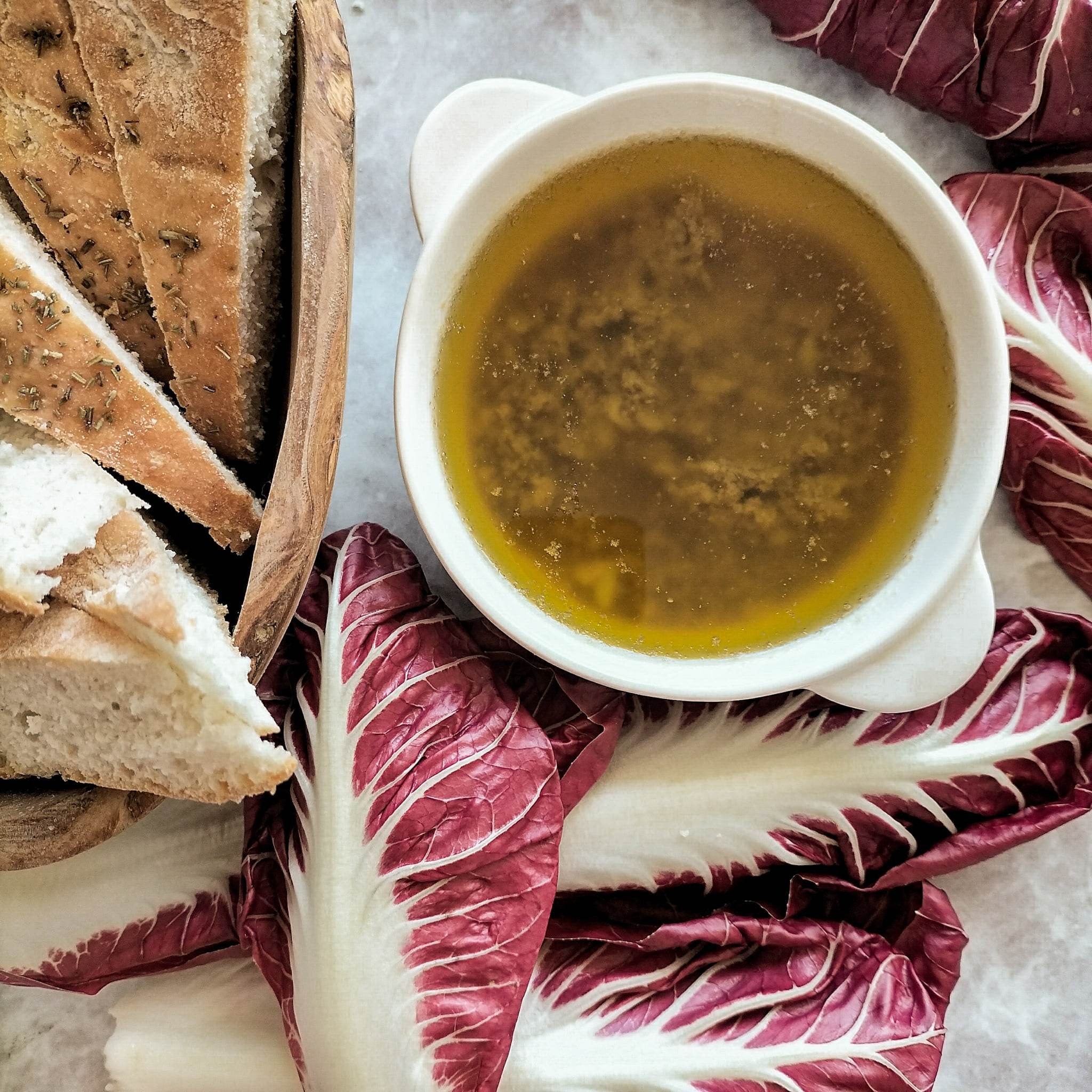Bagna Cauda, a beloved dish hailing from the Piedmont region of Italy, embodies the essence of communal dining. This warm, savory dip, made from anchovies, garlic, and olive oil, is traditionally served in a communal pot called a “fujot.” Perfect for gatherings with friends and family, Bagna Cauda pairs exquisitely with a variety of fresh and roasted vegetables, making it a versatile and hearty addition to any meal. In this comprehensive guide, we’ll explore two delightful variations of Bagna Cauda: the classic version and a creamy milk-infused rendition. Whether you’re a seasoned chef or a culinary novice, this recipe is sure to become a cherished favorite at your dining table.
Table of Contents
- Introduction
- Time
- Necessary Equipment
- Tags
- Serving Size
- Difficulty Level
- Allergen Information
- Dietary Preferences
- Course
- Cuisine
- Ingredients
- Instructions
- Preparation Tips
- Nutritional Information
- Tips and Tricks
- Add-ons
- Side Dishes
- Improvements
- Save and Store
- FAQ
- Conclusion
- References
Introduction
Bagna Cauda, translating to “hot bath” in Piedmontese, is a traditional Italian dip that has been enjoyed for centuries. Originating from the mountainous regions of Piedmont, this dish is a testament to the region’s rich culinary heritage and its emphasis on communal eating. The name aptly describes the warm, soothing nature of the dip, making it perfect for sharing during colder months. The classic version combines the umami depth of anchovies with the robust flavor of garlic, all harmoniously blended with high-quality olive oil. For those seeking a creamier texture, the milk-infused variation adds a luscious dimension to the traditional recipe.
Time
- Preparation Time: 30 minutes
- Cooking Time: 2.5 hours
- Total Time: Approximately 3 hours
Necessary Equipment
- Heavy-bottomed Pan: Essential for even heat distribution when cooking garlic and anchovies.
- Bowl: For desalinating the anchovies.
- Paper Towels: To pat dry the anchovies after desalting.
- Serving Pot (Fujot) or Heat-safe Serving Bowl: To keep the Bagna Cauda warm during serving.
- Cutting Board and Knife: For preparing vegetables.
- Oven: For roasting vegetables.
- Wooden Spoon: To stir ingredients without reacting with the olive oil.
- Saucepan: Specifically for the milk-infused version.
Tags
- Cuisine: Italian, Piedmontese
- Course: Appetizer, Starter
- Dietary Preferences: Vegetarian (if anchovies are omitted), Gluten-Free
- Difficulty Level: Intermediate
- Meal Type: Communal Dining, Sharing Dish
Serving Size
- Servings: 6-8
- Per Serving Nutritional Information:
- Calories: 500 kcal
- Protein: 8 g
- Fats: 45 g
- Carbohydrates: 15 g
- Fiber: 3 g
- Sodium: 450 mg
Difficulty Level
- Intermediate: While the recipe is straightforward, it requires attention to detail, especially in the desalination of anchovies and the careful cooking process to prevent burning the garlic.
Allergen Information
- Contains: Fish (anchovies)
- Potential Allergens: Dairy (in the milk-infused version)
- Note: Can be modified to accommodate various dietary restrictions by substituting ingredients as needed.
Dietary Preferences
- Vegetarian: Traditional Bagna Cauda is not vegetarian due to anchovies. However, a vegetarian version can be made by omitting anchovies or using a plant-based substitute.
- Gluten-Free: Naturally gluten-free, but always check labels for any added ingredients if using store-bought products.
- Dairy-Free: The classic version is dairy-free, while the milk-infused version contains dairy.
Course
- Appetizer: Ideal for starting a meal.
- Starter: Perfect for beginning a larger dining experience.
- Shared Dish: Designed for communal sharing, enhancing the dining experience.
Cuisine
- Italian: Rooted in the rich culinary traditions of Italy.
- Piedmontese: Specifically from the Piedmont region, known for its robust and flavorful dishes.
Ingredients
Classic Bagna Cauda Ingredients
| Ingredient | Quantity |
|---|---|
| Garlic | 570 g |
| Extra virgin olive oil | 600 g |
| Anchovies (salted) | 300 g |
| Red wine | 125 g |
| Bell peppers | As needed |
| Beets | As needed |
| Onions | As needed |
| Fresh spring onions | As needed |
| Barbera wine | As needed |
| Potatoes | As needed |
| Cardoons | As needed |
Milk-Infused Bagna Cauda Ingredients
| Ingredient | Quantity |
|---|---|
| Garlic | 570 g |
| Extra virgin olive oil | 600 g |
| Anchovies (salted) | 300 g |
| Red wine | 125 g |
| Milk (whole) | 350 g |
| Bell peppers | As needed |
| Beets | As needed |
| Onions | As needed |
| Fresh spring onions | As needed |
| Barbera wine | As needed |
| Potatoes | As needed |
| Cardoons | As needed |
Instructions
Classic Bagna Cauda Instructions
Step 1: Prepare the Garlic
- Peel the Garlic: Start by peeling 570 grams of garlic cloves, ensuring you remove the papery outer layers.
- Slice and Seed: Slice each clove lengthwise and carefully remove the central germ. This step is crucial to reduce the bitterness of the garlic, resulting in a smoother flavor profile.
Step 2: Desalinate the Anchovies
- Soak Anchovies: Place 300 grams of salted anchovies in a bowl filled with cold water.
- Soaking Time: Allow the anchovies to soak for 2 to 3 hours. During this time, change the water frequently to effectively remove excess salt.
- Dry the Anchovies: After soaking, gently separate the fillets to prevent them from breaking. Lay the cleaned fillets on a tray lined with paper towels and pat them dry thoroughly.
Step 3: Cook the Garlic
- Heat the Oil: In a heavy-bottomed pan, combine the prepared garlic with 100 grams of extra virgin olive oil.
- Low Heat Cooking: Place the pan over very low heat. Stir continuously with a wooden spoon to ensure the garlic cooks evenly without browning. The goal is to soften the garlic and infuse the oil with its flavor.
Step 4: Add the Anchovies
- Incorporate Anchovies: Once the garlic is softened, add the desalinated anchovy fillets to the pan.
- Add Remaining Oil: Pour in the remaining 500 grams of extra virgin olive oil.
- Simmer: Allow the mixture to simmer on low heat. Stir occasionally to ensure the anchovies dissolve completely into a creamy sauce. This process should take about 30-40 minutes until the sauce reaches a smooth consistency.
Step 5: Prepare the Vegetables
- Roasted Vegetables:
- Bell Peppers: Roast bell peppers in the oven until the skins are charred. Once cooled, peel off the skins and cut the peppers into wedges.
- Onions: Roast onions until caramelized and slice them into thick pieces.
- Boiled Vegetables:
- Potatoes: Boil potatoes until they are tender but still firm. Cut them into wedges for dipping.
- Raw Vegetables:
- Cardoons: Wash and trim cardoons, ensuring they are crisp and fresh. These add a unique flavor and texture to the assortment of vegetables.
Step 6: Serve
- Transfer the Sauce: Pour the warm Bagna Cauda sauce into a traditional “fujot” or a heat-safe serving bowl to keep it warm throughout the meal.
- Arrange Vegetables: Artistically arrange the prepared vegetables around the sauce, creating an inviting display for dipping.
- Enjoy: Serve immediately, allowing everyone to dip their chosen vegetables into the rich, flavorful sauce.
Milk-Infused Bagna Cauda Instructions
Step 1: Prepare the Garlic
- Peel the Garlic: Begin by peeling 570 grams of garlic cloves, removing the germ from each clove to ensure a smoother flavor.
Step 2: Desalinate the Anchovies
- Soak Anchovies: Place 300 grams of salted anchovies in a bowl of cold water.
- Soaking Time: Let them soak for 2 to 3 hours, changing the water frequently to eliminate excess salt.
- Dry and Prepare Anchovies: After soaking, pat the fillets dry with paper towels and remove the central bones if necessary to ensure a smooth texture.
Step 3: Cook Garlic in Milk
- Combine Garlic and Milk: In a saucepan, combine the prepared garlic with 350 grams of whole milk.
- Gentle Boil: Bring the mixture to a gentle boil over medium heat.
- Simmer: Reduce the heat and let it simmer for 15 to 20 minutes until the garlic softens and infuses the milk with its flavor.
Step 4: Cook the Anchovies
- Heat the Oil: In a separate pan, heat 150 grams of extra virgin olive oil over low heat.
- Add Anchovies: Introduce the desalinated anchovy fillets to the pan.
- Dissolve Anchovies: Gently cook the anchovies, stirring continuously until they dissolve into a smooth paste, creating a rich umami base for the sauce.
Step 5: Combine and Finish
- Merge Mixtures: Add the softened garlic along with the infused milk to the pan containing the anchovies.
- Blend Flavors: Stir the mixture thoroughly to ensure all flavors meld together seamlessly.
- Simmer: Allow the combined mixture to simmer on low heat for an additional 20 to 30 minutes. The goal is to maintain a creamy consistency without frying the ingredients, ensuring the sauce remains smooth and rich.
Step 6: Serve
- Transfer the Sauce: Pour the milk-infused Bagna Cauda into a “fujot” or a heat-safe serving dish to keep it warm.
- Arrange Vegetables: Surround the sauce with an assortment of prepared vegetables for dipping.
- Enjoy: Serve immediately, savoring the unique, creamy flavor profile of this delightful variation.
Preparation Tips
- Quality Ingredients: Using high-quality extra virgin olive oil and fresh garlic significantly enhances the flavor of Bagna Cauda.
- Anchovy Selection: Opt for premium salted anchovies, as they provide a deeper, more authentic taste.
- Gentle Cooking: Maintain low heat throughout the cooking process to prevent burning the garlic or anchovies, ensuring a smooth and rich sauce.
- Vegetable Variety: Incorporate a mix of raw and roasted vegetables to provide diverse textures and flavors for dipping.
Nutritional Information
Per Serving (Classic Bagna Cauda)
| Nutrient | Amount |
|---|---|
| Calories | 500 kcal |
| Protein | 8 g |
| Fats | 45 g |
| Carbohydrates | 15 g |
| Fiber | 3 g |
| Sodium | 450 mg |
Note: Nutritional values may vary based on specific ingredients and serving sizes.
Tips and Tricks
- Preventing Bitterness: Removing the central germ from garlic cloves is crucial to avoid bitterness, resulting in a smoother and more pleasant flavor.
- Salt Control: Proper desalination of anchovies ensures the dip is flavorful without being overly salty. Be patient during the soaking process and change the water frequently.
- Consistent Heat: Maintaining a consistent low heat prevents the garlic and anchovies from burning, which can impart a bitter taste to the sauce.
- Serving Warm: Bagna Cauda is best enjoyed warm. Keep the serving pot or bowl over a gentle heat source to maintain the desired temperature throughout the meal.
Add-ons
Enhance your Bagna Cauda experience with these delightful add-ons:
- Herbs: Fresh herbs like parsley or basil can add a burst of freshness.
- Cheese: A sprinkle of grated Parmesan or Pecorino cheese can complement the rich flavors.
- Crusty Bread: Serve with slices of crusty Italian bread or baguette for additional dipping options.
- Olives: A side of marinated olives can add a briny contrast to the savory dip.
Side Dishes
Complement your Bagna Cauda with these side dishes:
- Roasted Vegetables: Extend the variety with roasted zucchini, eggplant, or cherry tomatoes.
- Salads: A light green salad with a vinaigrette can balance the richness of the dip.
- Antipasto Platter: Include cured meats, cheeses, and pickled vegetables for a comprehensive appetizer spread.
- Grilled Meats: For non-vegetarian accompaniments, grilled sausages or meats pair well with Bagna Cauda.
Improvements
Elevate your Bagna Cauda with these enhancements:
- Infused Oils: Experiment with infusing the olive oil with herbs or spices like rosemary or chili flakes for added depth.
- Nut Addition: A touch of toasted pine nuts can introduce a subtle crunch and nuttiness.
- Wine Selection: Substitute red wine with different varieties like Merlot or Cabernet Sauvignon to vary the flavor profile.
- Vegan Version: Replace anchovies with plant-based alternatives such as capers or sun-dried tomatoes to create a vegan-friendly dip.
Save and Store
- Refrigeration: Store leftover Bagna Cauda in an airtight container in the refrigerator for up to 5 days.
- Reheating: Gently reheat the sauce on low heat, stirring frequently to restore its creamy consistency.
- Freezing: While not traditional, Bagna Cauda can be frozen for up to 3 months. Thaw in the refrigerator overnight before reheating.
- Shelf Life: Due to the high oil content, ensure the sauce is stored properly to prevent rancidity.
FAQ
Q1: Can I make Bagna Cauda ahead of time?
A1: Yes, you can prepare Bagna Cauda in advance. Store it in the refrigerator and gently reheat it on the stove before serving to maintain its smooth texture.
Q2: What vegetables pair best with Bagna Cauda?
A2: Traditional pairings include bell peppers, onions, cardoons, potatoes, beets, and fresh spring onions. However, you can also include vegetables like zucchini, cherry tomatoes, and carrots for added variety.
Q3: Is there a vegetarian version of Bagna Cauda?
A3: Yes, by omitting anchovies or using a plant-based substitute like capers or sun-dried tomatoes, you can create a vegetarian-friendly Bagna Cauda.
Q4: How do I prevent Bagna Cauda from solidifying when it cools?
A4: Keep the serving pot or bowl warm using a heat source like a candle warmer or a fondue burner. This helps maintain the sauce’s warm and smooth consistency.
Q5: Can I use fresh anchovies instead of salted ones?
A5: Fresh anchovies are not typically used for Bagna Cauda. Salted anchovies are preferred for their depth of flavor and texture after desalination.
Q6: What is the role of red wine in the recipe?
A6: Red wine adds acidity and complexity to the sauce, balancing the richness of the olive oil and anchovies. It enhances the overall depth of flavor in Bagna Cauda.
Q7: Can I substitute olive oil with another type of oil?
A7: While extra virgin olive oil is traditional and recommended for its robust flavor, you can experiment with other oils like grapeseed or avocado oil. However, this may alter the dish’s authentic taste.
Conclusion
Bagna Cauda is more than just a dip; it’s a celebration of communal dining and the rich culinary traditions of Italy’s Piedmont region. Whether you opt for the classic version with its deep umami flavors or the milk-infused variation that offers a creamy twist, this dish is sure to bring warmth and joy to your table. By following this comprehensive recipe and incorporating the tips and variations provided, you can create a memorable dining experience that honors tradition while allowing for personal creativity. Gather your loved ones, prepare this delightful dip, and savor the flavors that make Bagna Cauda a timeless favorite.
References
While this recipe is based on traditional methods and personal culinary expertise, further reading and inspiration can be found in Italian culinary literature and authentic Piedmontese cookbooks. For a deeper understanding of Bagna Cauda and its cultural significance, consider exploring:
- “The Cuisine of Northern Italy” by Alberto Capatti and Massimo Montanari
- “Piedmont: The Culinary Heritage of Italy’s Richest Region” by Maria C. V.
- Online resources and authentic Italian cooking websites
Enjoy your culinary journey with Bagna Cauda, and buon appetito!



